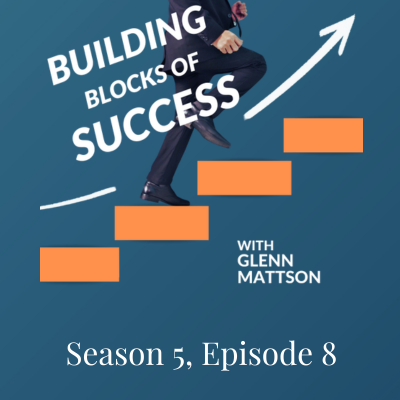
The content of this recording is copyrighted by Sandler Systems LLC. All rights reserved.
Glenn Mattson
Hey everybody. We're in season five. We're in episode eight right now. Really taking a look at the second part of dealing with staff when it comes to a rainmaking entrepreneurial. Remember, a rainmaking entrepreneur has the mindset that, they don't accept mediocrity, right? They understand time profitability. They're the individuals that if you can do it today, you do it today. And you know their mindset is though, the more we can do, the more we can get done. They kind of live in that mindset of six pounds of stuff into a three-pound bag.
Glenn Mattson
Unfortunately, at the beginning of this phase, they are more reactive than proactive with regards to staff, and they have to, they themselves, which we’ll get into, develop their own management and leadership skills, so they can actually go to the next level, which is now developing managers within their team, and then ultimately developing leaders. So what I want to do is spend a few minutes with you today, just talking about the skills and tools that you're going to need to have to make sure you hire the right type of individuals. I will say that a good 15, 20% of my time when I'm talking with individuals and coaching, they know they need to bring on staff. They know they need to bring on more people to delegate out some of the responsibilities that they're doing to others, but they've just done a really, really poor job doing it. So I want to walk you through a handful of things today that are tried and true, that you can do to really start to help yourself understand what you need, how to find that individual, how to bring them on board, and how to develop them.
Glenn Mattson
Now, there are a couple of things to remember as we go through this journey today. The first is, is that no one is ever going to be as good at doing the task as you are, right? And so we just have to make sure that you understand that that is, listen, you did it all on your own previously. Now you're hiring someone, and you expect them within three days to understand what you've taken, you know, four years or three years to master. Right? So when we look at this, what we really want to do is have the capacity to really drive this thing and make sure that they have the capacity to grow. Right?
Glenn Mattson
So what I want to do is share with you a couple of things. Okay, and especially if you have a high controller type mentality in the back of your brain, that means that you're going to push people. You think pushing people past their comfort zone is part of your job function, right? You're going to be almost intimidating other people, you're going to move seven miles an hour, and they're at one mile an hour, right? You're on chapter 15, and they don't even know what book you're on inside the library. On some levels, you feel really proud of that, but you have to realize that actually slows down the growth of your people.
Glenn Mattson
Okay, so being a straight talker is important, but you have to back up your controller-type mentality and your hyper-achiever-type mentality with a process and a track to run on. So let me talk to you about how to do that. So one of the things that, and I don't want to overcomplicate this with a lot of stuff if you ever need help, just reach out to us, more than happy to share the tools with you that we have to help individuals like yourself figure this thing out. So the first piece you have to ask yourself is, is that, as you go through this, and I'm going to jump around a little bit, but as you go through it as a job profile, and the first thing is to do that, is, you need to understand what the functions of the job are.
Glenn Mattson
Now, the functions of the job are, you know, for instance, are you looking for someone who's going to hunt for business? Are you going to look for someone who has an expanded business? Are you looking for someone who can take a file, open it up, and find where there's new business? Are you looking for someone who can just service follow-up? Are you looking for someone who can expand and develop new relationships and qualify? Are you looking for someone who is exceedingly detail-oriented and can fulfill a task but doesn't, doesn't do a great follow-up? So the first function is understanding what the job function is.
Glenn Mattson
Is your turnaround time quick, or is it long? Is service fixing a problem or just making sure people are aware of how to solve the problem? So the first thing you have to ask yourself is, really, what is my job function? Do they have to work in a team, or they're gonna have to work by themselves? Are they gonna have to work on one task to get it done? Or do they have to work on multiple tasks at the same time without forgetting to get things done? So if they're going to be served. Saying, well, what's the rate of speed that your expectation is to get the service done and turnaround time? So the first part really is your job function, which is you gotta ask, is it sales? Is it service? Is it ownership? Is it follow-through? Is it paperwork, etc? Do you want them to be more robotic, or do you want them to have a capacity so that your clients love them, and they get to know their clients? So the first function is really a job what we call a job function. It's one of the tools that we have. And again, feel free to reach out to us. More than happy to send this stuff to you. The second piece is you're going to have to form or create what we call a job profile, right?
Glenn Mattson
So a job profile is now breaking down those functions into really, what's a criteria? So, you know, take, for instance, a junior salesperson. What's the sales cycle that they're going to have to be familiar with? Are they going to be a hunter or a farmer? They're going to be out there attaining new business or expanding current do they have to have the ability to find it and qualify it, or do they have to have the ability to actually close it also? So are they going to have to file systems in great detail, or is it just get the deal done and don't worry about it? Are they going to be in a long sales cycle or a short sale cycle? So that starts to help you create based on the job functions, a profile. Now, the neat thing about a profile is that we understand what in essence, the top responsibilities are. Then we go to something called a search model. The search model is an acronym, so make sure you write it down. It's S, E, A, R, C, H, and when you look at this, you're going to do two different search models. For me, one's generic, and general, and then a second one is gonna be by function. So a search model stands for this. S stands for skills. E stands for experience. A stands for attitude. R stands for results. C stands for cognitive skills, and how smart they are. And the last one is habits. So again, searches, skills, experience, attitude, results, cognitive skills, and habits. Now realize that your skills should be connected to your experiences, which should be connected to your results.
Glenn Mattson
And always remember two things you always, almost always, fire someone or someone's let go because of poor attitude or lack of habits. So do not discount the attitude and habit section of the search model. To me, it's almost one of the most important pieces, depending on what you're looking for. So the first is really creating that search model of what you're looking for, and that could be a pretty laborious process. I had three people last week. One was doing a COO, one was doing what we call a second chair, and then one was doing someone who's an administration area, but it's important to understand what the search model is.
Glenn Mattson
Now, once we do that, you go to the next level, which is taking those job functions, those things that are critically important, that they have the ability to drive. And that could be, again, maybe it's paperwork, follow-through, compliance issues. Maybe it's because they're going to be hunting, finding new business outside. So it's prospecting. It's shaking the trees, the center of influences. So you must take a look at each of the job functions, and that could be technology-based, that could be sales-based, that could be customer service-based, but with each function, which means that if you had a magic wand, what would be the three or four things that they are exceedingly good at? That's part of your job function. From that now what you can do, and one of the tools that we have, is to break each of these job functions down into a search model because the skills are different.
Glenn Mattson
If you want someone who can service to keep a client, or are you looking for someone to service to expand a client, with different skills, different attitudes, and different results, you know you do. It's called the search model, by the actual job profile, the job function is really, really powerful. What I typically will tell people is, you know, I need someone to do X. I said, Okay, I got that. What are the absolute top five things that are critically important that get accomplished? For you to say that role is being done the way it's supposed to be done? They usually give me those five then I turn around and say, okay, what are the skills that are must have? What are the skills that are nice to have? What's the experience that a must-have with the experience that's nice to have? What's the attitude that you need to have? What's the attitude nice to have? And go through that function actually creates a really good document that's creating what we call a search tool based on the profile. Very powerful. Now that leads to another issue, and that issue is really understanding, which I think people skip over quite a bit, is really what I call the values and the behaviors, or beliefs. So values.
Glenn Mattson
Things like honesty, integrity, flexibility. It could be a phrase, for instance, superior client service, right? Professional experience. But then you have beliefs. Belief is things like honesty, honesty, right? So you have to take a look at your values and beliefs, and again, if you need this, this is part of our teaming program, more than happy to send it to you, but one of the things that I found is, that I'll ask someone, and we have a list of about 70 of them, knock it down to 10 that are important to you. Then after they do that, I said, Okay, now you gotta get down to eight, then you gotta get down to five. Now sometimes these values and these beliefs are across the board for everybody. Okay, now, for instance, accountability, and ingenuity, right?
Glenn Mattson
Enthusiasm, excellence, pride, insightfulness, integrity, sincereness. So transparency, so you have to find out, what are the company values, and then what are the values per role like you necessarily don't want someone being creative in paperwork, or maybe you do right? Maybe for others that you want to have the ability for, follow-through is more important than anything else. Maybe in one role, patience is critical. But across the board in the company, accountability is one of the primaries, right? The commitment, and proper communication. So one of the things you need to understand is, what are the values, the beliefs, and the behaviors that drive your company?
Glenn Mattson
Now, once you get that together, then what you're actually going to create is what we call an onboarding document. An onboarding document looks at the first 30 days, 60 days, 90 days. And I typically will have a client just write down 30, 60, 90, and I'll say, okay, in the first 30 days, what do they need to own? Own? And then what do they need to know? So I just ask them to take a piece of paper and cut it right in half. The top half is own. The bottom half is no big difference between the two. By the two, by the way, own is they can do it almost all without you know is they have a working knowledge of it. And by the way, your no typically becomes your own for the next document. So it's 30 days, 60 days, and 90 days, and identify what they need to know versus what they need to own. Then from taking what they need to know to own, is two things, creating awareness and giving knowledge.
Glenn Mattson
So the awareness of knowledge now becomes part of your training program. So what do they need to master in the first 30 days? What you focus on, but part of those 30 days is you're also building the foundation for what they need to own in the next 30 days. So think of a staircase. Step up, step up, step up, step up. So this onboarding program is exceedingly powerful for your team to have an understanding of where they are and where they need to go. It also creates one hell of a scorecard to help you as a manager. Is what you put down accurate? What you're putting down, is it fair for the time that you're giving them to do it? Are they taking too much time to learn things that you know should only take 30 days? So remember, as you're hiring people, I always believe that you should hire attitudes and you should hire habits because you can develop the rest. And don't think just because someone has previous experience of being someone who's good at customer service, that they're going to be good at customer service with your type of job function.
Glenn Mattson
So spend time on what you want the top three to four functions or responsibilities of this role to be based on that. Make sure you do your search model by function. Then from there, that'll help you create your interviewing guide. But don't forget the values and the beliefs. I cannot tell you how many times, almost every time I have a conversation with someone, especially newer in the rainmaking phase, the reason they're letting go of one of their staff is that they don't have the right values and beliefs to drive the execution of what they think is important, I'll hear all the time, yeah, they sent out an email and they thought they did. Follow through. Follow through to many isn't an action. It means it's completed, so make sure you have clarity on exactly what your expectations are when you expect them, but it also means that your training program must mimic your onboarding program.
Glenn Mattson
So there's a lot of small pieces to this, but this map really is going to help you identify how to figure out what that puzzle looks like that you're looking for, so that once you have clarity and really what you're looking for, now going out and getting it and creating those interviewing questions becomes that much easier. I just had a coaching call the other day, and he was telling me he was really looking for a second chair, as we started going through the documents that I was talking to you about, he wasn't looking for a second chair. He was really looking for someone who had great skills and great experiences but had the right values and mindset where they could actually work at a different level, but more of a mentorship level than it is an owner-level role.
Glenn Mattson
So take these skills. Take a look at how you can make sure that you have clarity in what you're looking for. Clarity on making sure that you can identify who you're talking to actually can fulfill that role. And most importantly, when they come on board, having a development program that I believe, is 30, 60, 90 days, 120 days, you should absolutely have the first six months mapped out by month, and then after that, you should go to three-month increments for the next year and a half, and that'll create your scorecards. And I have found no one in the 30 years of helping that had great scorecards, that had a bad person, and those that had bad scorecards. We got rid of them or not rid of them. They decided to graduate out of the company sooner, which then had the ability for the Rainmaker to go find the right person to sit on that seat of the bus. So hopefully this has helped to figure out how to make sure that when you're looking for someone in your head, you're not sure how to put pen to paper to really start to take a look at that functions, the job profile, then your search, to create your interviewing questions and your onboarding and as always, more than happy to help you with the tools. Feel free to reach out to Mattson Enterprises and more than happy to help you with that. But until then, next section, we're going to be talking about how to really start to create managers out of your team to start having more ownership in what they do, so that you can become a better leader and they can become a better manager. And until then, as always, good selling on the Building Blocks of Success
Glenn Mattson
This is the Building Blocks of Success with Glenn Mattson.






